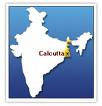 |
Although the name Kalikata had been mentioned in the rent-roll of the Great Mughal emperor Akbar and also in Manasa-Mangal, to explore the history of Calcutta, we have to go back to the 17th century. It was in 1690....Job Charnock came on the bank of the river Hooghly (it's the part of the Ganges) and took the lease of three large villages along the east bank of the river - Sutanuti, Govindapur and Kolikata (Calcutta) as a trading post of British East India Company. The site was carefully selected, being protected by the Hooghly River on the west, a creek to the north, and by salt lakes about two and a half miles on the east. These three villages were bought by the British from local landlords. The Mughal emperor granted East India Company freedom of trade in return for a yearly payment of 3,000 rupees.
Before the British came Calcutta was just a village, the capital city of Bengal was Murshidabad, about 60 miles north of Calcutta. In 1756, Siraj-ud-daullah, nawab of Bengal, attacked the city and captured the fort. Calcutta was recaptured in 1757 by Robert Clive when the British defeated Siraj-ud-daullah on the battlefield of Plassey and recaptured the city. Warren Hastings, the first Governor-General of India, made it the seat of the supreme courts of justice and the supreme revenue administration, and Calcutta became the capital of British India in 1772. All important offices were subsequently moved from Murshidabad to Calcutta. By 1800 Calcutta had become a busy and flourishing town, the centre of the cultural as well as the political and economic life of Bengal.
Calcutta became the centre of all cultural and political movements in entire India. The 19th century Renaissance and Reformation in India was pioneered in this city. Raja Rammohan Roy, Ishwar Chandra Vidyasagar, Sri Ramakrishna Paramhansa, Swami Vivekananda, Rabindra Nath Tagore, Jagadish Chandra Bose, Satyendra Nath Bose (co-author of Bose-Einstein Theory) and many more eminent personalities enhanced the cultural heritage of the city of Calcutta.
Till 1912, Calcutta was the capital of India, when the British moved the capital city to Delhi. In 1947, when India gained freedom and the country got partitioned between India and Pakistan, Calcutta was included in the Indian part of Bengal, West Bengal. Calcutta became the capital city of the state of West Bengal. |














